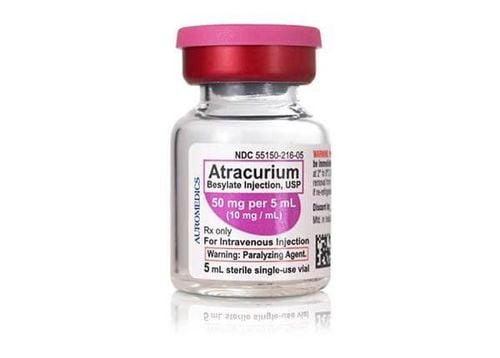This is an automatically translated article.
Lambertu is a drug that belongs to the group of drugs that relax muscles and increase muscle tone. The drug contains the main active ingredient, Pyridostigmine bromide, 60mg strength and is packaged in the form of film-coated tablets.1. What is the drug lambertu?
The ingredient Pyridostigmine bromide in the drug is a quaternary ammonium compound that inhibits Cholinesterase enzyme activity similar to Neostigmine, but the effect of Pyridostigmine appears slower and lasts longer, so the drug containing the active ingredient Pyridostigmine is used. mainly in the treatment of myasthenia gravis.Besides, the interval between doses of Pyridostigmine will be longer than that of Neostigmin, making it easier for patients to adhere to treatment for myasthenia gravis. On the other hand, it is possible to be flexible in combining Pyridostigmine with Neostigmin in the treatment of myasthenia gravis such as: using Pyridostigmine during the day and evening, and Neostigmin alone in the morning.
The drug contains the active ingredient Pyridostigmine for a systemic cholinergic response that causes: increased skeletal and intestinal muscle tone, mydriasis, uterine contractions, bronchial smooth muscle spasm, bradycardia, increased secretion in the exocrine glands.
2. Indications - contraindications to the use of Lambertu
Lambertu is indicated for use in the treatment of myasthenia gravis.
Contraindications of Lambertu include:
Contraindications to Lambertu in people with known hypersensitivity to anticholinesterase drugs; Intestinal obstruction or mechanical urinary tract obstruction.
3. Dosage and usage of Lambertu
Use Lambertu orally to treat myasthenia gravis:
The dose of Lambertu may change from day to day, depending on the improvement or worsening of the disease, the emotional and physical stress of the patient. The dose of Lambertu drug must be adjusted so that the patient takes a high dose at the time of greatest exertion (30-45 minutes before eating to help the patient improve when it is difficult to swallow); Adults and adolescents: First use Lambertu 30 to 60 mg, every 3-4 hours. After that, the maintenance dose of Lambertu is from 60 to 1200 mg per day (usually 600 mg). Children: The total daily dose of Lambertu is usually 7 mg/kg body weight (or 200 mg/m2 body area) in 5 or 6 divided doses. The first dose of Lambertu may be 30 mg for children < 6 years old or 60 mg for children 6 to 12 years old. This dose of Lambertu is gradually increased by 15 - 30 mg daily, until the desired effect is achieved, however, the total dose should not exceed 360 mg/day. Signs and symptoms of Lambertu overdose (acetylcholine attack):
Muscarinic effects: Abdominal cramps, increased intestinal motility, diarrhea, nausea, vomiting, excessive salivation and bronchial fluid , sweating, pupil constriction; Nicotinic effects: cause muscle weakness, local muscle spasticity, cramps; Side effects on the central nervous system: Agitation, restlessness, loss of reflexes, slurred speech; Circulatory: Slow heart rate, low blood pressure, possibly even cardiac arrest; Gastrointestinal: The earliest symptoms of Lambertu overdose are anorexia, nausea/vomiting, abdominal cramps, diarrhea. Treatment of Lambertu drug overdose:
Stop Lambertu drug immediately; The muscarinic effects of Lambertu are the most severe and can be controlled with atropine (2mg intravenously, then intramuscularly every 2-4 hours, depending on response to reduce dyspnea), care must be taken to avoid overdose. atropine; The effects of Lambertu on skeletal muscle after pyridostigmine overdose cannot be alleviated by atropine treatment; People with anticholinesterase poisoning should not use Aminophyllin, Morphine, Phenothiazine, tranquilizers, Reserpine, Succinylcholine, Theophylline; Do not administer large volumes of fluid.
4. Drug interactions of the drug Lambertu
Atropin antagonizes the muscarinic effects of Pyridostigmine, doctors will take advantage of this interaction to counteract the muscarinic effects when Pyridostigmine poisoning occurs; Dexpanthenol may synergize with Lambertu by increasing the production of Acetylcholine. Anticholinesterase agents such as Lambertu are effective in reversing neuromuscular blockade caused by aminoglycoside antibiotics. However, aminoglycoside antibiotics, anesthetics and anesthetics, antiarrhythmic drugs, drugs that interfere with neuromuscular conduction should be used with caution in patients with severe myasthenia gravis. The dose of Lambertu may have to be increased accordingly.
5. Side effects of the drug Lambertu
The most common side effect of Lambertu is vomiting, which is often related to an overdose of Lambertu. The main symptom of Lambertu overdose in myasthenia gravis is increased muscle weakness.
Common side effects of the drug Lambertu:
Systemic effects: Increased sweating, loss of appetite; Bradycardia , but occasionally tachycardia; Nausea, increased peristalsis, abdominal pain, salivation; Increased secretions in the respiratory tract, bronchospasm, symptoms of rhinitis; Muscle weakness, mild paralysis, convulsions or partial muscle spasms; Involuntary urination; Miosis, lacrimation, blurred vision, conjunctivitis. Less common side effects of Lambertu: Dizziness; Hypertension, hypotension; Restless sleep...
Rare side effects: Skin rash; Hair loss.
6. Pay attention to caution when using Lambertu
Lambertu should be used with caution in patients with epilepsy, bronchial asthma, bradycardia, patients with coronary occlusion, patients with parasympathetic hyperthyroidism, hyperthyroidism, arrhythmias or gastric ulcers. Avoid taking large doses of Lambertu in patients with an enlarged colon or in patients with reduced gastrointestinal motility. In some people, the active ingredient Pyridostigmine bromide lasts longer than the active ingredient Neostigmine, in these cases may cause episodes of increased acetylcholine secretion. When using Lambertu for the treatment of myasthenia gravis, it should be borne in mind that the same dose of anticholinesterase drugs can produce different responses in particular muscle groups: the drug can cause muscle weakness in this muscle group while causing muscle weakness. increase muscle strength in other muscle groups. Muscles in the neck, chewing and swallowing muscles are often the first muscle groups to weaken in an overdose of Lambertu. It is necessary to measure vital capacity every time Lambertu dose is increased to adjust the dose appropriately and ensure good respiratory function. Pyridostigmine can cross the placenta and is excreted in human milk, so Lambertu should be used with caution in pregnancy and lactation. The use of drugs with anticholinergic or atropine-like effects requires extreme caution when co-administering Lambertu because symptoms of atropine overdose may be masked, or conversely, symptoms of pyridostigmine overdose. may also be masked by atropin and atropine analogues. Keep Lambertu out of the reach of children. The safety of Lambertu in pregnancy has not been established, but anticholinesterase drugs can cause uterine stimulation and premature delivery when administered intravenously to a pregnant woman about to give birth. In one study, the active ingredient Pyridostigmine was used during pregnancy and did not cause malformations in the fetus. However, temporary muscle weakness occurs in about 10-20% of neonates due to mothers taking anticholinesterase drugs to treat myasthenia gravis. Therefore, the use of Lambertu for pregnant women needs to weigh the benefits and harms to the mother and the baby in the womb. Pyridostigmine is partially excreted in breast milk, so Lambertu should not be used during breast-feeding.
Please dial HOTLINE for more information or register for an appointment HERE. Download MyVinmec app to make appointments faster and to manage your bookings easily.













